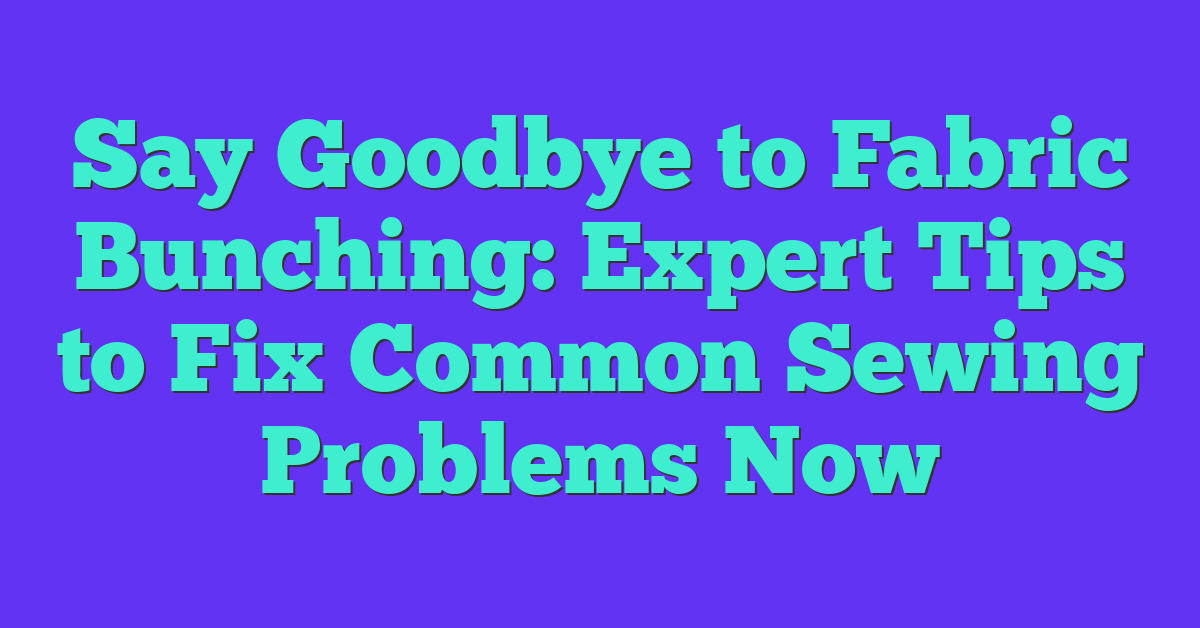Ever found yourself in the middle of a sewing project, only to notice your fabric bunching up? It’s one of those pesky problems that can turn an enjoyable hobby into a frustrating experience. Whether you’re a seasoned seamstress or a beginner, fabric bunching can happen to anyone and often at the most inconvenient times.
But don’t worry, you’re not alone. Many sewing enthusiasts face this issue, and there are simple solutions to help you get back on track. In this article, we’ll explore why fabric bunching occurs and share some handy tips to prevent it, so you can keep your sewing projects smooth and stress-free.
Understanding Sewing Problem Bunching
Fabric bunching, where material gathers or wrinkles during sewing, can interrupt any project. Knowing why bunching occurs helps to prevent this issue.
Causes of Fabric Bunching
Several factors contribute to fabric bunching:
- Incorrect Tension: Improperly set machine tension causes uneven stitching, leading to bunching. Make sure both upper and lower thread tension are balanced.
- Needle Issues: A dull or damaged needle can’t pierce fabric correctly, creating bunches. Replace needles regularly based on your project type.
- Thread Problems: Low-quality or incompatible thread can tangle and cause bunching. Use high-quality thread matching the fabric type.
- Fabric Feed Issues: An uneven fabric feed, usually due to improper placement or feed dog settings, leads to bunching. Ensure fabric feeds smoothly through the machine.
- Aesthetic Flaws: Visible wrinkles or gathers ruin the professional look of a project. Smooth, even stitches contribute to an excellent finish.
- Time Consumption: Fixing bunching issues consumes valuable project time. Reworking sections or repairing damage leads to delays.
- Material Waste: Bunching can damage fabric, making sections unusable. Accurately sewn pieces reduce material waste, saving resources.
Common Solutions to Prevent Bunching
To combat fabric bunching and achieve smoother sewing results, several simple yet effective solutions are available. By following these tips, you’ll notice a marked improvement in your sewing projects.
Adjusting Thread Tension
Improper thread tension often leads to fabric bunching. Adjust the upper and lower thread tensions for a balanced stitch. For the upper tension, locate the tension dial on your sewing machine. Increasing the tension tightens the upper thread, while decreasing it loosens it. For the bobbin tension, locate the screw on the bobbin case. Tightening the screw increases the tension, while loosening it decreases it. Consult your machine’s manual for specific instructions regarding tension adjustments.
Choosing the Right Needle and Thread
Using the correct needle and thread can prevent bunching. Match the needle size to the fabric weight—use a finer needle for lightweight fabrics and a thicker needle for heavyweight fabrics. The thread should also complement the fabric. Polyester threads work well with most fabrics, while cotton threads are suitable for natural fibers. Ensure the needle is not damaged or worn, as this can lead to bunching. Frequently changing the needle after 8-10 hours of sewing maintains optimal stitching quality.
By implementing these solutions, you can significantly reduce fabric bunching and enhance the overall quality of your sewing projects.
Advanced Tips for Smooth Sewing
Optimizing your sewing techniques can greatly reduce fabric bunching and improve the quality of your projects.
Importance of Proper Presser Foot Pressure
Proper presser foot pressure ensures smooth fabric movement. Improper settings can cause the fabric to skew or bunch, disrupting your stitch consistency. Adjust the presser foot pressure based on fabric thickness. For instance, lower pressure for lightweight fabrics like chiffon, and higher pressure for thicker materials like denim. Refer to your sewing machine’s manual to locate the adjustment knob or dial. Testing on a fabric scrap helps dial in the right pressure before starting your main project.
Maintaining Your Sewing Machine
Regularly maintaining your sewing machine is crucial for smooth operation. Clean lint and dust from the bobbin area and feed dogs after every project. Use the appropriate sewing machine oil to lubricate the moving parts, usually once every few months. Replace needles regularly, ideally after every 8-10 hours of sewing, to avoid dullness. Ensure thread paths are clear and tension discs are free from debris. If your machine requires more extensive service, consult a professional technician to avoid long-term issues.
Sewing Techniques to Avoid Bunching
Bunching can disrupt your sewing projects. Follow these expert techniques to keep your fabric smooth and stitches even.
Sewing Machine Settings for Different Fabrics
Settings affect fabric handling. Adjust the tension, stitch length, and presser foot pressure based on the fabric you’re using.
- Cotton & Linen
- Tension: Set tension to medium.
- Stitch Length: Use a standard stitch length of 2.5mm.
- Presser Foot Pressure: Medium pressure works best.
- Silk & Satin
- Tension: Lower the tension to prevent puckering.
- Stitch Length: Shorten the stitch length to 2mm.
- Presser Foot Pressure: Use minimal pressure for smooth movement.
- Wool & Fleece
- Tension: Keep tension slightly higher.
- Stitch Length: Lengthen to 3-4mm for even stitches.
- Presser Foot Pressure: Increase pressure to handle thicker fabric.
- Knit Fabrics
- Tension: Lighten the tension to avoid stretching.
- Stitch Length: Use a medium stitch length of 2.5-3mm.
- Presser Foot Pressure: Light pressure to maintain fabric elasticity.
Hand Sewing Tips for Bunch-Free Results
Hand sewing requires steady technique to avoid bunching. Here are essential tips:

- Use A Thimble
- Facilitates better control over needle movements.
- Select The Right Needle
- Choose finer needles for light fabrics, and thicker needles for heavy fabrics.
- Thread Tension Control
- Keep tension even to prevent pulling on the fabric.
- Small Stitches
- Smaller stitches (3-4mm) help maintain fabric placement.
- Frequent Knotting
- Knot thread frequently to secure layers and prevent loosening.
By carefully adjusting machine settings and following hand sewing techniques, you can achieve smooth, beautiful results free from frustrating fabric bunching.
Conclusion
Tackling fabric bunching in your sewing projects can feel like a daunting task but with the right techniques and adjustments it’s entirely manageable. By paying attention to thread tension needle choices and presser foot pressure you can significantly improve your sewing experience.
Remember that different fabrics require different settings so taking the time to adjust your machine accordingly can make all the difference. Whether you’re using a machine or sewing by hand these tips will help you achieve smooth and professional-looking results.
Happy sewing!

















